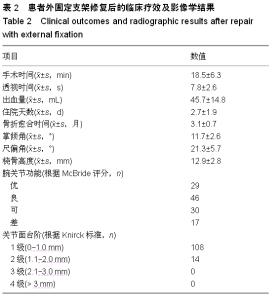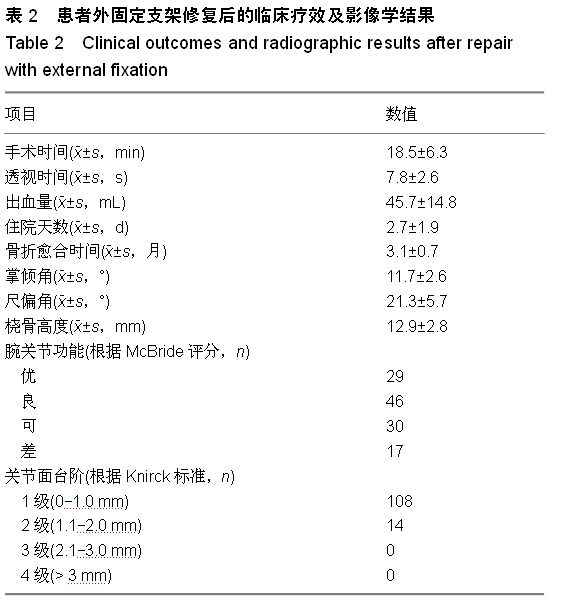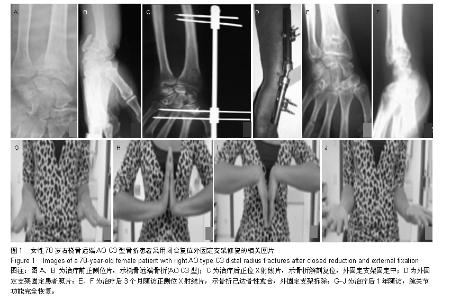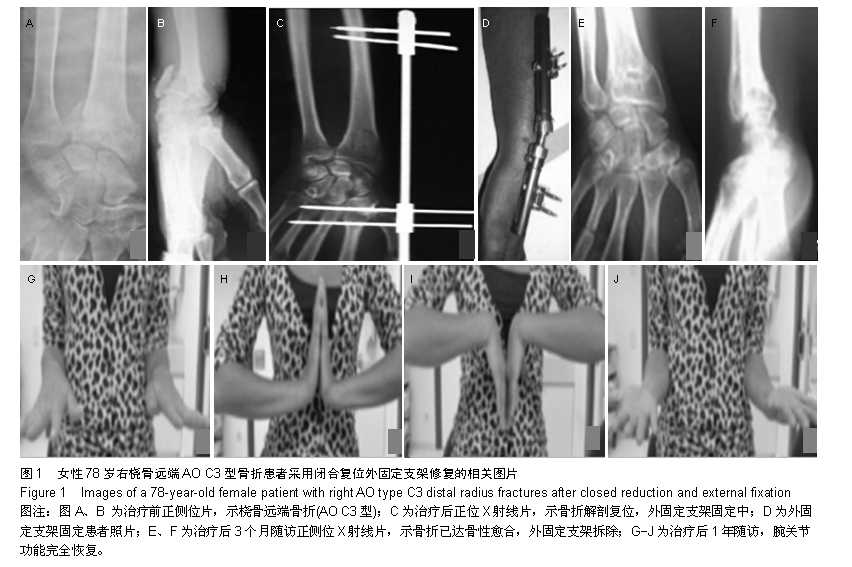Chinese Journal of Tissue Engineering Research ›› 2015, Vol. 19 ›› Issue (35): 5684-5690.doi: 10.3969/j.issn.2095-4344.2015.35.021
Previous Articles Next Articles
Closed reduction and external fixation for treatment of AO type C distal radius fractures in the elderly: biological advantage
Huang Xiao-nan
- Department of Bone Surgery, Heze Municipal Hospital, Heze 274031, Shandong Province, China
-
Received:2015-06-04Online:2015-08-27Published:2015-08-27 -
About author:Huang Xiao-nan, Master, Attending physician, Department of Bone Surgery, Heze Municipal Hospital, Heze 274031, Shandong Province, China
CLC Number:
Cite this article
Huang Xiao-nan. Closed reduction and external fixation for treatment of AO type C distal radius fractures in the elderly: biological advantage [J]. Chinese Journal of Tissue Engineering Research, 2015, 19(35): 5684-5690.
share this article
| [1] Meisinger C, Wildner M, Stieber J, et al. Epidemiology of limb fractures. Orthopade. 2002; 31(1):92-99. [2] Cummings SR, Melton LJ. Epidemiology and outcomes of osteoporotic fractures. Lancet. 2002; 359(9319): 1761-1767. [3] Nguyen ND, Ahlborg HG, Center JR, et al. Residual lifetime risk of fractures in women and men. J Bone Miner Res. 2007; 22(6):781-788. [4] Rachner TD, Khosla S, Hofbauer LC. Osteoporosis: now and the future. Lancet. 2011; 377(9773):1276-1287. [5] Sambrook P, Cooper C. Osteoporosis. Lancet. 2006; 367 (9527): 2010-2018. [6] Bartl C, Stengel D, Bruckner T, et al. The Treatment of Displaced Intra-articular Distal Radius Fractures in Elderly Patients. Dtsch Arztebl Int. 2014; 111(46):779-787. [7] 金粉勤,薛锋,徐雪荣,等.外固定支架与钢板内固定治疗桡骨远端不稳定型骨折的疗效比较[J].中华创伤骨科杂志,2013,15(1): 87-89. [8] Paksima N, Panchal A, Posner MA, et al. A meta-analysis of the literature on distal radius fractures: review of 615 articles. Bull Hosp Joint Dis. 2004; 62(1-2):40-46. [9] Kawaguchi S, Sawada K, Nabeta Y, et al. Recurrent dorsal angulation of the distal radius fracture during dynamic external fixation. J Hand Surg Am. 1998; 23(5):920-925. [10] Laulan J, Bismuth JP, Clément P, et al. An analytical classification of fractures of the distal radius: The "M.E.U." classification. Chir Main. 2007; 26(6):293-299. [11] Cooney WP, Bussey R, Dobyns JH, et al. Difficult wrist fractures. Clin Orthop Relat Res. 1987; (214):136-147. [12] Green DP, O’Brien ET. Open reduction of carpal dislocations: indications and operative techniques. J Hand Surg. 1978; 3(3): 250-265. [13] Knirk JL, Jupiter JB. Intra-articular fractures of the distal end of the radius in young adults. J Bone Joint Surg Am. 1986; 68(5):647-659. [14] Haus BM, Jupiter JB. Intra-articular fractures of the distal end of the radius in young adults: reexamined as evidence-based and outcomes medicine. J Bone Joint Surg Am. 2009; 91(12): 2984-2991. [15] Porrino JA Jr, Maloney E, Scherer K, et al. Fracture of the distal radius: epidemiology and premanagement radiographic characterization. AJR Am J Roentgenol.2014; 203(3): 551-559. [16] Kumbaraci M, Kucuk L, Karapinar L, et al. Retrospective comparison of external fixation versus volar locking plate in the treatment of unstable intra-articular distal radius fractures. Eur J Orthop Surg Traumatol. 2014; 24(2):173-178. [17] 吕浩然,邹云雯,何二兴,等.两种方法治疗老年桡骨远端不稳定型骨折的疗效比较[J].中华创伤骨科杂志,2010,12(5):447-450. [18] 邓迎生,张秋林,王秋根,等.掌侧锁定加压钢板与外固定支架治疗不稳定桡骨远端C型骨折的比较研究[J].中华创伤骨科杂志, 2007,9(10):935-939. [19] 黄海晶,温建民.钢板内固定与小夹板治疗桡骨远端关节内骨折的效果比较[J].中国组织工程研究,2014,18(4):631-636. [20] 郭勇,林旭,谭伦等.跨腕关节钢板与外固定支架治疗桡骨远端粉碎骨折的疗效比较[J].中华创伤骨科杂志,2011,13(8):704-709. [21] 努尔哈那提•沙依兰别克,李忠伟,金格勒等.老年人桡骨远端骨折治疗后腕关节屈伸及旋转活动的Meta分析[J].中国组织工程研究,2014,18(17):2770-2776. [22] Bartl C, Stengel D, Bruckner T, et al. Open reduction and internal fixation versus casting for highly comminuted and intra-articular fractures of the distal radius (ORCHID): protocol for a randomized clinical multi-center trial. Trials. 2011; 12:84. [23] Grewal R, MacDermid JC, King GJ, et al. Open reduction internal fixation versus percutaneous pinning with external fixation of distal radius fractures: a prospective, randomized clinical trial. J Hand Surg Am. 2011; 36(12):1899-1906. [24] Jeudy J, Steiger V, Boyer P, et al. Treatment of complex fractures of the distal radius: a prospective randomised comparison of external fixation 'versus' locked volar plating. Injury. 2012; 43(2):174-179. [25] Moradi A, Ebrahimzadeh MH, Jupiter JB. Intra-articular fractures of the distal radius: bridging external fixation in slight flexion and ulnar deviation along articular surface instead of radial shaft. Tech Hand Up Extrem Surg. 2014; 18(1):41-50. [26] 徐农,倪红联,李旱雨,等. 背侧入路微型锁定钢板内固定治疗桡骨远端背侧不稳定骨折[J].中华手外科杂志, 2015, 31(1): 21-23. [27] 陈柯屹,杨广忠,马创,等.钢板内固定与外固定架治疗桡骨远端不稳定骨折的Meta分析[J].中国组织工程研究,2013,17(39): 6962-6969. [28] Tarallo L, Mugnai R, Zambianchi F, et al. Volar plate fixation for the treatment of distal radius fractures: analysis of adverse events. J Orthop Trauma. 2013; 27(12):740-745. [29] Rozental TD, Blazar PE. Functional outcome and complications after volar plating for dorsally displaced, unstable fractures of the distal radius. J Hand Surg Am. 2006; 31(3):359-365. [30] Pichler W, Windisch G, Schaffler G, et al. Computer tomography aided 3D analysis of the distal dorsal radius surface and the effects on volar plate osteosynthesis. J Hand Surg Eur. 2009; 34(4):598-602. [31] Casaletto JA, Machin D, Leung R, et al. Flexor pollicis longus tendon ruptures after palmar plate fixation of fractures of the distal radius. J Hand Surg Eur. 2009; 34(4):471-474. [32] Drobetz H, Kutscha-Lissberg E. Osteosynthesis of distal radial fractures with a volar locking screw plate system. Int Orthop. 2003; 27(1):1-6. [33] Figl M, Weninger P, Weninger P, et al. Unstable distal radius fractures in the elderly patient-volar fixed-angle plate osteosynthesis prevents secondary loss of reduction. J Trauma. 2010; 68(4):992-998. [34] Chin KR, Jupiter JB. Wire-loop fixation of volar displaced osteochondral fractures of the distal radius. J Hand Surg Am. 1999; 24(3):525-533. [35] Takami H, Takahashi S, Ando M. Comminuted intra-articular fracture of the distal radius with rotation of the palmar medial articular fragment: case reports. J Trauma. 1992; 32(3): 404-407. [36] Harness NG, Jupiter JB, Orbay JL, et al. Loss of fixation of the volar lunate facet fragment in fractures of the distal part of the radius. J Bone Joint Surg Am. 2004; 86(9):1900-1908. [37] Fernandez DL, Jakob RP, Buchler U. External fixation of the wrist. Current indications and technique. Ann Chir Gynaecol. 1983; 72(6):298-302. [38] Bass RL, Blair WF, Hubbard PP. Results of combined internal and external fixation for the treatment of severe AO-C3 fractures of the distal radius. J Hand Surg. 1995; 20(3):373-381. [39] Huch K, Hunerbein M, Meeder PJ. External fixation of intra-articular fracture of the distal radius in young and old adults. Arch Orthop Trauma Surg. 1996; 115(1):38-42. [40] Geissler WB, Fernandez DL. Percutaneous and limited open reduction of the articular surface of the distal radius. J Orthop Trauma.1991; 5(3):255-264. [41] Jakim I, Pieterse HS, Sweet MB. External fixation for intra-articular fractures of the distal radius. J Bone Joint Surg Br. 1991; 73(2):302-306. [42] Chan BK, Leong LC, Low CO, et al. The use of the external fixator in the treatment of intra-articular fractures of the distal radius. Singapore Med J. 1999; 40(6):420-424. [43] Cooney WP. External fixation of distal radial fractures. Clin Orthop Relat Res. 1983;(180):44-49. [44] Goslings JC, Broekhuizen AH, Boxma H, et al. Three-dimensional dynamic external fixation of distal radial fractures. A prospective study. Injury. 1999; 30(6):421-430. [45] Gausepohl T, Pennig D, Mader K. Principles of external fixation and supplementary techniques in distal radius fractures. Injury. 2000; 31(suppl 1):56-70. [46] Hayes AJ, Duffy PJ, McQueen MM. Bridging and non-bridging external fixation in the treatment of unstable fractures of the distal radius: a retrospective study of 588 patients. Acta Orthopaedica. 2008; 79(4):540-547. [47] Esposito J, Schemitsch EH, Saccone M, et al. External fixation versus open reduction with plate fixation for distal radius fractures: a metaanalysis of randomised controlled trials. Injury. 2013; 44(4):409-416. [48] Walenkamp MM, Bentohami A, Beerekamp MS, et al. Functional outcome in patients with unstable distal radius fractures, volar locking plate versus external fixation: a meta-analysis. Strategies Trauma Limb Reconstr. 2013; 8(2):67-75. [49] Xie X, Xie X, Qin H, et al. Comparison of internal and external fixation of distal radius fractures. Acta Orthopaedica. 2013; 84(3): 286-291. [50] Wilcke MK, Abbaszadegan H, Adolphson PY. Wrist function recovers more rapidly after volar locked plating than after external fixation but the outcomes are similar after 1 year. Acta Orthopaedica. 2011; 82(1):76-81. [51] Edwards GS Jr. Intra-articular fractures of the distal part of the radius treated with the small AO external fixator. J Bone Joint Surg Am. 1991; 73(8):1241-1250. [52] Abramo A, Kopylov P, Geijer M, et al. Open reduction and internal fixation compared to closed reduction and external fixation in distal radial fractures: a randomized study of 50 patients. Acta Orthop. 2009; 80(4):478-485. [53] Grewal R, Perey B, Wilmink M, et al. A randomized prospective study on the treatment of intra-articular distal radius fractures: open reduction and internal fixation with dorsal plating versus mini open reduction, percutaneous fixation, and external fixation. J Hand Surg. 2005; 30(4): 764-772. [54] Xu GG, Chan SP, Puhaindran ME, et al. Prospective randomised study of intra-articular fractures of the distal radius: comparison between external fixation and plate fixation. Ann Acad Med Singapore. 2009; 38(7):600-606. [55] Kreder HJ, Hanel DP, Agel J, et al. Indirect reduction and percutaneous fixation versus open reduction and internal fixation for displaced intra-articular fractures of the distal radius: a randomised, controlled trial. J Bone Joint Surg. 2005; 87(6):829-836. [56] Leung F, Tu YK, Chew WY, et al. Comparison of external and percutaneous pin fixation with plate fixation for intra-articular distal radial fractures. A randomized study. J Bone Joint Surg Am. 2008; 90(1): 16-22. [57] MacDermid JC, Turgeon T, Richards RS, et al. Patient rating of wrist pain and disability: a reliable and valid measurement tool. J Orthop Trauma. 1998; 12(8):577-586. [58] Imaeda T, Uchiyama S, Wada T, et al. Reliability, validity, and responsiveness of the Japanese version of the Patient-Rated Wrist Evaluation. J Orthop Sci. 2010; 15(4):509-517. [59] Phadnis J, Trompeter A, Gallagher K, et al. Mid-term functional outcome after the internal fixation of distal radius fractures. J Orthop Surg Res. 2012;7:4. [60] 杨召,马信龙,马剑雄,等. 动态外固定架与静态外固定架治疗不稳定桡骨远端骨折远期疗效的Meta分析[J].中国矫形外科杂志, 2014,22(10):880-885. |
| [1] | Zhang Jing, Wang Bin, Lü Xin. Application of anatomic intramedullary nail in tubular bone fractures of limbs: stronger holding force and anti-rotation ability [J]. Chinese Journal of Tissue Engineering Research, 2021, 25(6): 917-922. |
| [2] | Wu Shitong, Ning Rende, Fang Run, Bi Chenghao. Therapeutic effects of different fixation methods of fragment of the dorsal ulnar of distal radius fracture [J]. Chinese Journal of Tissue Engineering Research, 2021, 25(21): 3343-3348. |
| [3] | He Xiangzhong, Chen Haiyun, Lü Yang, Liu Jun, Huang Junhan, Gao Shihua, Guan Jianhao, Wang Yangfa. Meta-analysis of repairing pronator muscle after metacarpal plate fixation of distal radius fracture [J]. Chinese Journal of Tissue Engineering Research, 2021, 25(15): 2423-2429. |
| [4] | Yan Wei, Jiang Tao, Wu Changgui, Kong Bo, Xi Xiaobing. Progress in the study of appearance, material and fixation band of splint for distal radius fracture [J]. Chinese Journal of Tissue Engineering Research, 2020, 24(9): 1430-1434. |
| [5] | Xia Changjiang, Yuan Zhifeng, Fang Ning. Biomechanical characteristics of the distal radius fracture based on three-dimensional finite element model of ulna and radius [J]. Chinese Journal of Tissue Engineering Research, 2020, 24(6): 893-897. |
| [6] | Chen Xiaojun, Luo Tao, Ou Changliang, He Zhiyu, Zhou Xin, Tang Xincheng, Mo Deping, Zou Yonggen. Comparison of external fixator-assisted reduction and locking plate internal fixation and simple locking plate internal fixation in the treatment of type C distal radius fractures [J]. Chinese Journal of Tissue Engineering Research, 2020, 24(33): 5315-5320. |
| [7] | Ye Shuming, Xu Chungui, Zhang Jisen, Xu Xinzhong, Xu Youjia, Jing Juehua. Effect of healing of ulnar styloid fracture on joint function after distal radius fracture surgery [J]. Chinese Journal of Tissue Engineering Research, 2020, 24(33): 5321-5325. |
| [8] | Hu Chaoyan, Wu Zhifang, Huang Fei, Yu Runai, Xie Peiyi, Chen Yanjun, Luo Yiwen. 3D printed orthopedic cast combined with Zicao oil promotes the recovery of wrist joint function after distal radius fracture [J]. Chinese Journal of Tissue Engineering Research, 2020, 24(30): 4763-4768. |
| [9] | Li Yongyao, Zhao Yong, Cheng Hao, Xu Huiqing, Wei Xu, Liu Guangwei, Cheng Yongzhong, Cui Xin. Finite element analysis of intervention of splint to ulnar column in the treatment of type Frykman VIII fracture of distal radius [J]. Chinese Journal of Tissue Engineering Research, 2020, 24(30): 4769-4774. |
| [10] | Yang Shun, Chen Keyi, Cheng Yabo, Xiang Wang, Zhang Jing, Gu Hongji, Chi Haotian. Wrist arthroscopy-assisted titanium internal fixator for the treatment of complex distal radius fractures [J]. Chinese Journal of Tissue Engineering Research, 2020, 24(3): 366-371. |
| [11] | Li Yongyao, Zhao Yong, Cheng Hao, Xu Huiqing, Wei Xu, Liu Guangwei, Cheng Yongzhong, Cui Xin. Establishment and mechanical analysis of the finite element model of the type Frykman VIII fracture of the distal radius with steel plate fixation [J]. Chinese Journal of Tissue Engineering Research, 2020, 24(27): 4272-4277. |
| [12] | Yang Xiao, Mei Wei, Zhang Wei. Absorbable rod or titanium alloy screws for Mason type II radial head fractures [J]. Chinese Journal of Tissue Engineering Research, 2020, 24(27): 4328-4332. |
| [13] | Li Zhongxian, Ji Yucheng, Weng Yujie, Ning Pengfei. Mongolian osteopathy in the treatment of ulna-radius fractures: finite element analysis of mechanical principle [J]. Chinese Journal of Tissue Engineering Research, 2020, 24(21): 3293-3298. |
| [14] | Mu Shuai, Xiao Peng, Zhang Jianliang, Hou Weiguang. Incidence of femoral neck shortening after internal fixation of femoral neck fracture and prognostic factors [J]. Chinese Journal of Tissue Engineering Research, 2020, 24(21): 3304-3309. |
| [15] | Chen Yanming, Liu Mingjiang, Xie Songlin, Liu Changxiong, Song Jiangang. Skin flap transplantation combined with membrane induction technique for repair of long bone defects and soft tissue defects [J]. Chinese Journal of Tissue Engineering Research, 2020, 24(16): 2551-2555. |
| Viewed | ||||||
|
Full text |
|
|||||
|
Abstract |
|
|||||



